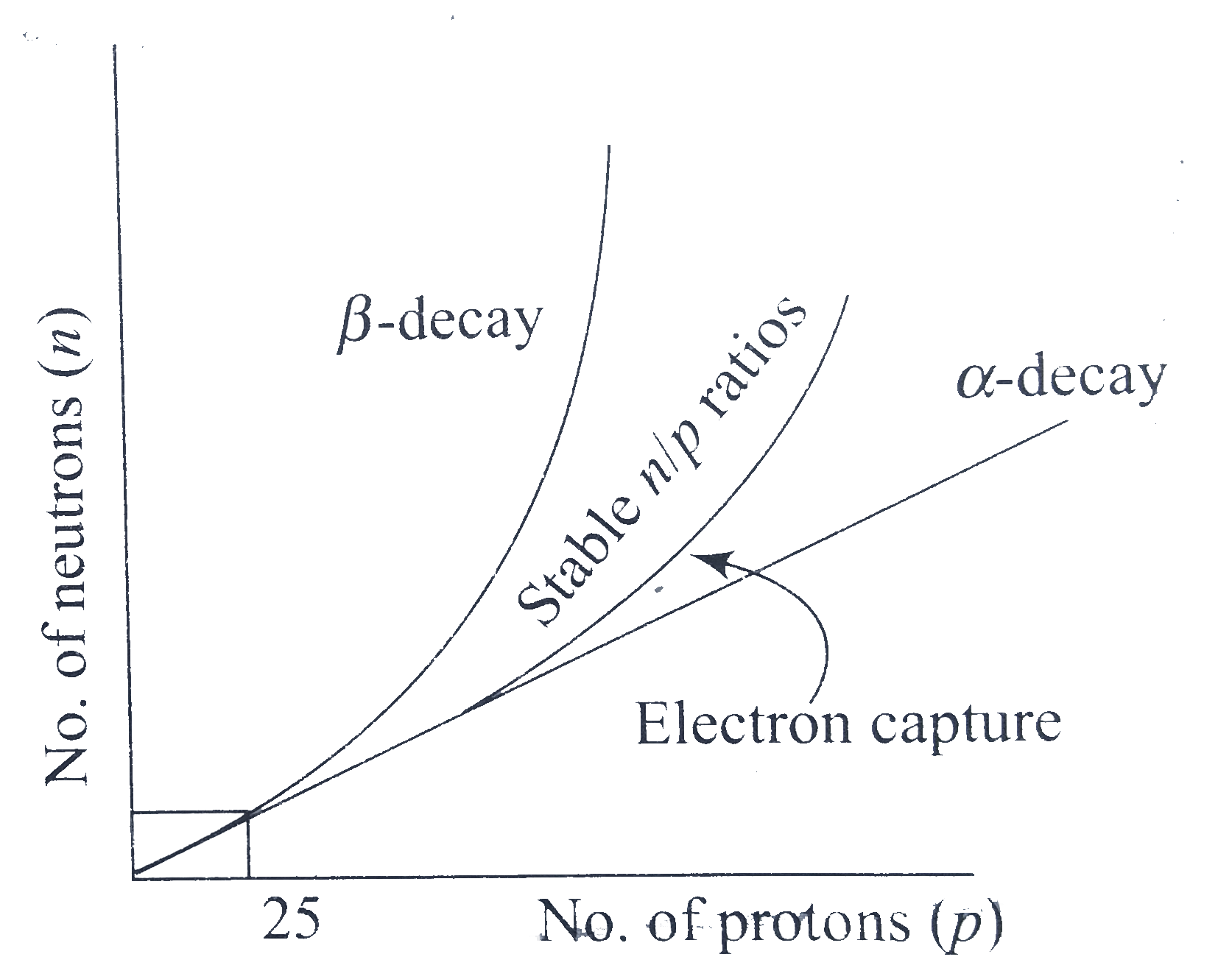Various rules of thumb have seen proposed by the scientific community to expalin the mode of radioactive decay by various radioisotopes. One of the major rules is called the n/p ratio. If all the known isotopes of the elemnts are plotted on a graph of number of neutrons (n) versus number of protons (p), it is observed that all isotopes lying outside of a ''stable'' n/p ratio region are radioactive as shown fig. The graph exhibits straight line behaviour with unit slope up to p=25. Above p=25, tgose isotopes with n/p ratios lying above the stable region usually undergo beta decay. Very heavy isotopes (p>83) are unstable because of their relativley large nuclei and they undergo alpha decay. Gamma ray emission does not involve the release of a particle. It represnts a change in an atom from a higher energy level to a lower energy level.

How would the radioisotope of magnesium with atomic mass 27 undergo radioactive decay?.
electron capture
alpha decay
beta decay
gamma ray emission
The correct Answer is:c
From the graph and the fact that the n/p(=no. of neutrons/no.of protons) ratio for magnesium is 27/12, which is greater than 1(=unit slope).
Topper's Solved these Questions
- NUCLEAR PHYSICSBOOK - CENGAGE PHYSICSCHAPTER - NUCLEAR PHYSICSEXERCISE - Integer
6 Videos
- NUCLEAR PHYSICSBOOK - CENGAGE PHYSICSCHAPTER - NUCLEAR PHYSICSEXERCISE - Fill In The Blanks
5 Videos
- NUCLEAR PHYSICSBOOK - CENGAGE PHYSICSCHAPTER - NUCLEAR PHYSICSEXERCISE - Single Correct Option
182 Videos
- Moving charges and magnetismBOOK - CENGAGE PHYSICSCHAPTER - Moving charges and magnetismEXERCISE - Question Bank
20 Videos
- NUCLEIBOOK - CENGAGE PHYSICSCHAPTER - NUCLEIEXERCISE - QUESTION BANK
59 Videos
Similar Questions
.92U238 changes to .85At210 by a series of α-and β-decays. Find the number of α-decays undergone (an integer).
View SolutionAtoms having the same …… but different ….. are called isotopes .
View SolutionAn element A decays into element C by a two-step process :
A→B+.2He4
B→C+2e¯
Then.
View SolutionTwo circulat coils of radii ratio 1: 2 and turn ratio 4: 1, respectively, are connected in series, The ratio of value of magnetic field at their centre is
View SolutionThe half lives of radioactive elements X and Y are 3 minute and 27 minute respectively. If the activities of both are same, then calculate the ratio of number of atoms of X and Y.
View SolutionVarious rules of thumb have seen proposed by the scientific community to expalin the mode of radioactive decay by various radioisotopes. One of the major rules is called the n//p ratio. If all the known isotopes of the elemnts are plotted on a graph of number of neutrons (n) versus number of protons (p), it is observed that all isotopes lying outside of a ''stable'' n//p ratio region are radioactive as shown f The graph exhibits straight line behaviour with unit slope up to p=25 . Above p=25 , tgose isotopes with n//p ratios lying above the stable region usually undergo beta decay. Very heavy isotopes (pgt83) are unstable because of their relativley large nuclei and they undergo alpha decay. Gamma ray emission does not involve the release of a particle. It represnts a change in an atom from a higher energy level to a lower energy level. Th-230 undergoes a series of radioactive decay processes resulting in Bi-214 being the final product. What was the sequence of the processes that occured?
View SolutionVarious rules of thumb have seen proposed by the scientific community to expalin the mode of radioactive decay by various radioisotopes. One of the major rules is called the n//p ratio. If all the known isotopes of the elemnts are plotted on a graph of number of neutrons (n) versus number of protons (p), it is observed that all isotopes lying outside of a ''stable'' n//p ratio region are radioactive as shown fig.5.28. The graph exhibits straight line behaviour with unit slope up to p=25 . Above p=25 , tgose isotopes with n//p ratios lying above the stable region usually undergo beta decay. Very heavy isotopes (pgt83) are unstable because of their relativley large nuclei and they undergo alpha decay. Gamma ray emission does not involve the release of a particle. It represnts a change in an atom from a higher energy level to a lower energy level. Which of the following represents the relative penetrating power of the three types of radioactive emission in decreasing order?
View SolutionAn element with mass number 81 contains 31.7% more neutrons as compared to protons. Write the symbol for the isotope in the standard fromat.
Strategy: Let us assume that the number of protons =p. Then, Number of neutrons (n)=p+31.7%of p
View SolutionA plot of the number of neutrons (n) against the number of protons (p) of stable nuclei exhibits upward deviation from linearity for atomic number, Zgt 20. For an unstable nucleus having n//p ratio less than 1, the possible mode (s) of decay is (are)
View SolutionConsider the following statements : (I)n All isotopes of an elements have the same number of neutrons. (II) only one isotope of an element can be stable and non-radioactive. (III) All elements have isotopes (IV) All isotopes of Carbon can form chemical compounds with Oxygen - 16
View SolutionThe plot of the number (N) of decayed atoms versus activity (R) of a radioactive substance is
View SolutionRadioactive isotopes that have an excessive neutron/proton ratio generally exhibit
View SolutionA plot of the number of neutrons (n) against the number of protons (p) of stable nuclei exhibits upward deviation from linearity for atomic number, Z>20. For an unstable nucleus having n/p ratio less than 1, the possible mode (s) of decay is (are)
View SolutionA plot of the number of neutrons (n) against the number of protons (p) of stable nuclei exhibits upward deviation from linearity for atomic number, Z > 20. For an unstable nucleus having n, p ratio less than 1, the possible mode(s) of decay is(are)
View Solutionহাইড্রোজেনের কোন আইসোটোপে নিউট্রন সংখ্যা ও প্রোটন সংখ্যা অনুপাত (np)- এর মান 2
View Solution